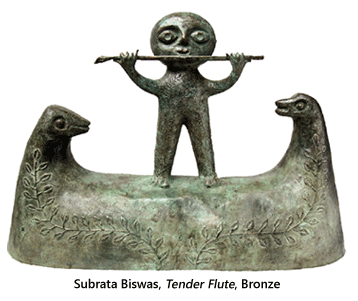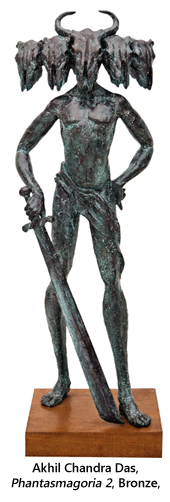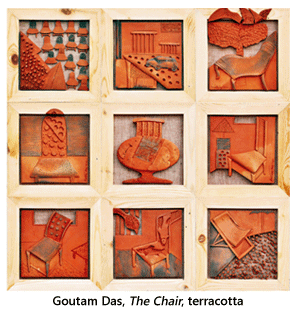- Publisher's Note
- Editorial
- Love of Life (that) Spills Over
- A Continuing Multiplication
- From Painting to Print
- Intimate Involvement
- Portrait of the Artist as an Old Man
- (Hi)Story of the Garhi Printmaking Studios, New Delhi
- Surinder Chadda
- Ramendranath Chakravorty
- Group 8
- Mother and Child: A Screenplay
- Straddling Worlds
- A Brief History of Printmaking at Santiniketan
- Vignettes from History
- Southern Strategies
- The Forgotten Pioneer: Rasiklal Parikh
- Printmaking in the City Of Joy
- Amitabha Banerjee: His Art and Aesthetic Journey
- Local Style and Homogenizing trends: Early Medieval Sculpture in Galaganatha
- English China: Delicate Pallid Beauty
- The Beauty of 'Bilal'
- Photo Essay
- The Way of The Masters: The Great Artists of India 1100 –1900
- Striving Towards Objectivity
- The Art of Sculpting In the Contemporary Times
- An Artistic Framework for an Alternative to Ecology
- Bidriware and Damascene Work in Jagdish and Kamla Mittal Museum of Indian Art
- A Lowdown on the Print Market
- The 'bubble' and the 'wobble'
- What Happened and What's Forthcoming
- Art Bengaluru
- Art Events Kolkata: June – July 2011
- Musings from Chennai
- Mumbai Art Sighting
- Previews
- In the News
- Christie's Jewellery Auction at London, South Kensington
ART news & views
The Art of Sculpting In the Contemporary Times
Volume: 3 Issue No: 19 Month: 8 Year: 2011
by Sarmistha Maiti

Kolkata: Contemporary Sculptures the show that took place at the Emami Chisel Art, Kolkata from July 14 - July 31, 2011 was a blend of an invocation and execution of the passion behind sculpting that has always been engrossingly vibrant with the joy of procreation.  The works exhibited in the show reflecting the diversity in thought process and uniqueness in approach and individual language bring forth the account of sculpture-making that takes us through a journey where artists have again and again sought after that eternal energy in the manifestation of their thoughts. The history of sculpture-making takes us through the journey of this profound practice of art, be it in 'conceiving form in depth' as in the humanist tradition or in search of absolute values of 'pure form' or may be in Herbert Read's words, “…the modern period has seen the invention of three-dimensional works of art which are in no sense 'sculpted' or moulded. They are built up, like architecture, or constructed like a machine”, and thus the joy of procreation in the art of sculpting is inevitable.
The works exhibited in the show reflecting the diversity in thought process and uniqueness in approach and individual language bring forth the account of sculpture-making that takes us through a journey where artists have again and again sought after that eternal energy in the manifestation of their thoughts. The history of sculpture-making takes us through the journey of this profound practice of art, be it in 'conceiving form in depth' as in the humanist tradition or in search of absolute values of 'pure form' or may be in Herbert Read's words, “…the modern period has seen the invention of three-dimensional works of art which are in no sense 'sculpted' or moulded. They are built up, like architecture, or constructed like a machine”, and thus the joy of procreation in the art of sculpting is inevitable.
From the tradition of image-making till sculpting as  one of the most innovative, conceptual and ideational discourse of aesthetics, sculptors have remained engaged in experimenting with techniques, materials and mediums. And when the idea of an exhibition has been conceived to showcase Contemporary Sculptures, with globalization at the backdrop, the art of sculpting is ought to become an amalgamation of various art forms being executed with a much broader connotation and new syntax. That can be presumed pretty well behind the idea of hosting this show where each sculptor has dealt with invariable layers of thoughts and execution techniques, yet they could be taken on the same platter with a common and composite identity and thus unique to hold the essence of contemporaneity in the 21st century reaching out to the global periphery from its local base.
one of the most innovative, conceptual and ideational discourse of aesthetics, sculptors have remained engaged in experimenting with techniques, materials and mediums. And when the idea of an exhibition has been conceived to showcase Contemporary Sculptures, with globalization at the backdrop, the art of sculpting is ought to become an amalgamation of various art forms being executed with a much broader connotation and new syntax. That can be presumed pretty well behind the idea of hosting this show where each sculptor has dealt with invariable layers of thoughts and execution techniques, yet they could be taken on the same platter with a common and composite identity and thus unique to hold the essence of contemporaneity in the 21st century reaching out to the global periphery from its local base.
Tapas Sarkar's Flying form in bronze and Biman B Das's Building Joy XX also in bronze though hold the same spirit of freedom yet are built completely on different structures and mechanisms. Tapas has dealt with the whirlpool of motions, Biman has kept it more composed and fixed. Sunil Kumar Das also worked in bronze but keeping with the conventional texture and composing process with this material in his works Bondage and Donkey with Bird and at the ideational level they too reflected the essence of contemporary times. Bimal Kundu's Animal in bronze transcended the material quality and the finesse of the sculpture had the capacity to instigate the viewer to feel the touch of the body and possibly every sculptor would covet for one such experience.
Uma Siddhanta in her regular mode of execution even here dealt with the robust and the grotesque quality of bronze as a metal in contrast to its ductility and luster quality.  Manik Talukder's Fantasy in wood was more towards the inclination of a world of desire and Asim Basu's Repose in bronze was in contrast depicting anguish, agony and the metaphysics of angst. Sunanda Das had quite resemblance of the similar reflection where as Tapas Kumar Das and Ram Kumar Manna were on the other side of the journey with full of enigma, compassion, passion and joy. Shyamal Roy handled terracotta with the basic attribute of creating masked faces such as Clown where as Debotash Kar assimilated the latest technique of installing sculpture with scrap, junk material, regular usables and modern gadgets like comb and toothbrush.
Manik Talukder's Fantasy in wood was more towards the inclination of a world of desire and Asim Basu's Repose in bronze was in contrast depicting anguish, agony and the metaphysics of angst. Sunanda Das had quite resemblance of the similar reflection where as Tapas Kumar Das and Ram Kumar Manna were on the other side of the journey with full of enigma, compassion, passion and joy. Shyamal Roy handled terracotta with the basic attribute of creating masked faces such as Clown where as Debotash Kar assimilated the latest technique of installing sculpture with scrap, junk material, regular usables and modern gadgets like comb and toothbrush.
Akhil Chandra Das, Subrata Biswas, Sutanu Chatterjee, Ashis Ghosh, Pankaj Panwar all of them dealt with bronze in their individual style sometimes with the caricature style and sometimes with a formal pattern of casting bronze and conceptually deals with tales from Indian mythology with a blend of folk culture.  In the entire show Janak Jhankar Narzary stood out with a distinct quality of formal devising and ideational executions of marble and stone cutting with the mechanism of force and labour equated to engrave and give shape to the art of sculpture. Narzari's stylistics propagated that energy and vigor through his venture in the sculpting world yet with the flavour of contemporariness.
In the entire show Janak Jhankar Narzary stood out with a distinct quality of formal devising and ideational executions of marble and stone cutting with the mechanism of force and labour equated to engrave and give shape to the art of sculpture. Narzari's stylistics propagated that energy and vigor through his venture in the sculpting world yet with the flavour of contemporariness.
With such variation in work-style and dynamism in conceptualization, this show stands distinctively a serious effort to promulgate a panorama of novel ventures in the trend of modern sculpting. Such challenges in procreating thoughts mark the possibility of setting new discourses in the art of sculpting in totality.